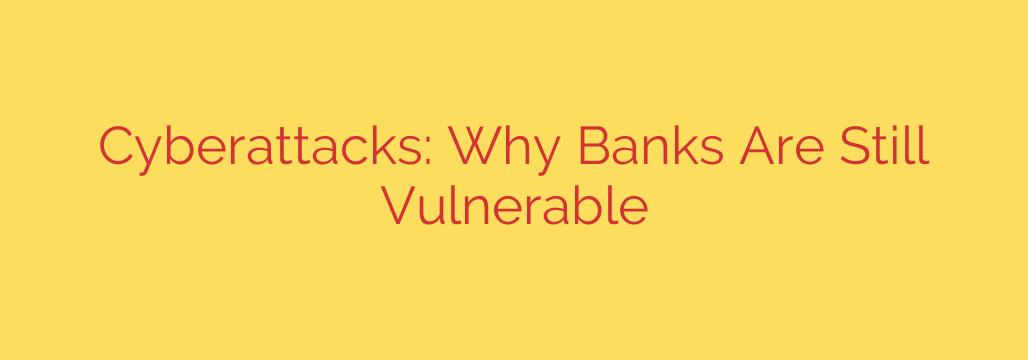
Beyond the Vault: Uncovering Why Banks Remain Top Targets for Cyberattacks
We often think of banks as digital fortresses, protected by impenetrable layers of security. They invest billions annually in cybersecurity, employing top experts to safeguard our financial data. Yet, despite these massive investments, financial institutions remain one of the most targeted and vulnerable sectors for cybercriminals.
The reality is that the digital banking landscape is far more complex and exposed than a physical vault. While the industry has made significant strides, several persistent vulnerabilities leave them, and their customers, at risk. Understanding these weaknesses is the first step toward building a more secure financial future.
The Ever-Expanding Digital Footprint
The biggest shift in modern banking is the move away from brick-and-mortar branches to digital-first services. Mobile apps, online portals, and interconnected financial ecosystems offer incredible convenience, but they also create new doors for attackers to knock on.
The rapid expansion of digital services has exponentially increased the “attack surface” for cybercriminals. Every new app, third-party integration, or API (Application Programming Interface) that connects a bank to a fintech partner is a potential entry point. Securing a single, centralized network is one thing; securing a sprawling, interconnected web of services is a far greater challenge. Attackers no longer have to breach the central fortress; they can simply find a weakly protected window in one of the many connected buildings.
The Escalating Sophistication of Threats
Today’s cyberattacks are a far cry from the simple email viruses of the past. Criminal organizations and even state-sponsored groups are launching highly sophisticated and patient campaigns designed to circumvent traditional defenses.
Key threats include:
- Advanced Phishing and Social Engineering: These aren’t just poorly-worded emails anymore. Attackers use stolen data to craft highly personalized messages (spear phishing) that trick employees or customers into divulging credentials or installing malware.
- Destructive Ransomware: For a bank, a ransomware attack is a nightmare scenario. It doesn’t just steal data; it encrypts critical systems, potentially halting operations entirely. The goal is to force a massive payout to restore access, causing financial and reputational ruin.
- Supply Chain Attacks: Why attack the bank directly when you can compromise one of its trusted software vendors? By injecting malicious code into software updates used by the bank, attackers can gain a trusted foothold inside the network.
Modern cyberattacks are not random; they are well-funded, targeted operations that exploit both technology and human psychology with chilling efficiency.
The Human Element: An Overlooked Weakness
A bank can have the best security technology in the world, but it can all be undone by a single moment of human error. Employees are on the front lines, and they are constantly targeted by attackers using social engineering tactics.
A convincing phone call, a cleverly disguised email, or even a misplaced USB drive can be all it takes for an attacker to gain initial access. While banks conduct security training, the fast-paced environment and the sheer volume of daily interactions create constant opportunities for mistakes. Technology can only go so far; the human element remains a critical, and often exploited, vulnerability.
The Burden of Legacy Systems
Many established banks are built on decades-old technology. While they may have a sleek, modern mobile app on the front end, the back-end systems that process transactions and manage accounts are often a complex patchwork of legacy infrastructure.
This “technical debt” creates significant security challenges. Many banks operate on a complex web of old and new technology, creating security gaps that are difficult to find and close. These older systems are often harder to patch, monitor, and integrate with modern security tools. Replacing them is an incredibly expensive and disruptive process, leaving security teams to do their best to protect an aging and inherently fragile foundation.
Protecting Your Finances: A Shared Responsibility
While banks bear the primary responsibility for securing their systems, customers are not powerless. In this environment, personal vigilance is essential.
How You Can Secure Your Financial Life
- Enable Multi-Factor Authentication (MFA): This is the single most effective step you can take. MFA requires a second form of verification (like a code from your phone) in addition to your password, making it much harder for attackers to access your account even if they steal your login credentials. Always enable MFA on every financial account that offers it.
- Practice Password Diligence: Use long, complex, and unique passwords for each of your financial accounts. A password manager can help you create and store them securely. Never reuse passwords across different websites.
- Be Skeptical of All Unsolicited Communication: Treat any unexpected email, text message, or phone call claiming to be from your bank with suspicion. Banks will never ask you for your full password, PIN, or MFA code. If you are unsure, hang up and call the bank directly using the number on their official website or the back of your card.
- Monitor Your Accounts Regularly: Set up transaction alerts and check your statements frequently. The sooner you spot unauthorized activity, the faster you and your bank can act to resolve it.
True financial security in the digital age is a partnership. As banks work to shore up their defenses against increasingly sophisticated threats, we as customers must do our part to secure our own corner of the digital world. By staying informed and practicing good security hygiene, we can build a stronger, more resilient defense together.
Source: https://www.tripwire.com/state-of-security/bullseye-banks-why-financial-services-remain-prime-target-cyberattacks








